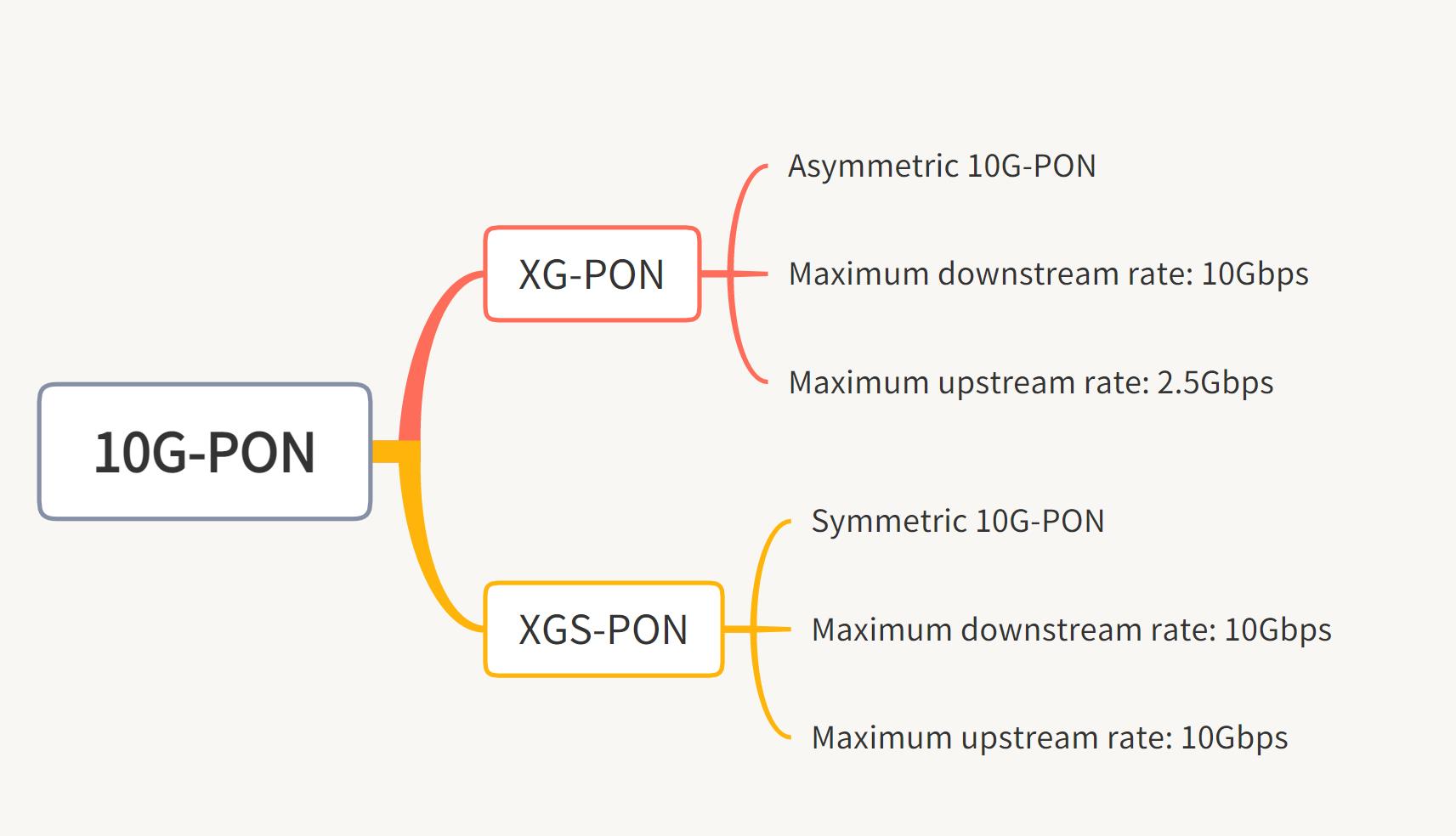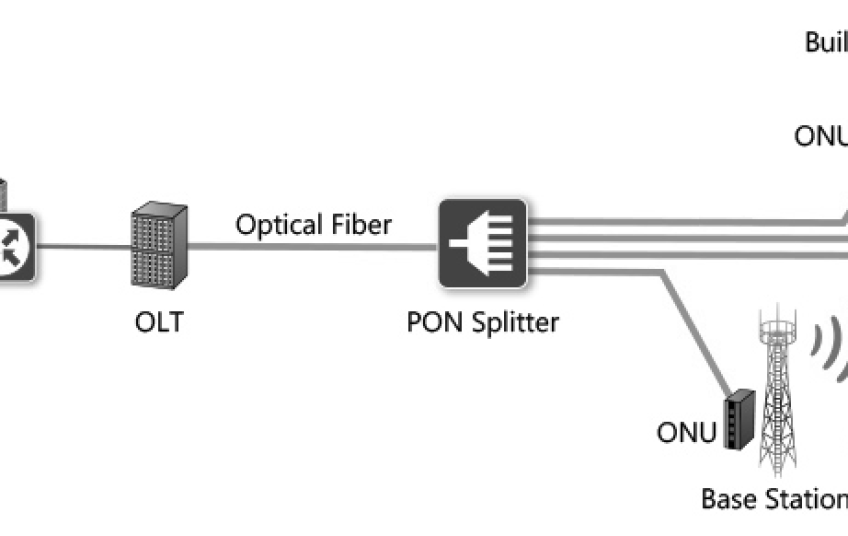Passive optical network (PON) technology has emerged as one of the dominant technologies for building Fiber-to-the-X (FTTx) networks. As users’ demand for high bandwidth continues to grow, especially with the popularity of high-traffic applications such as OTT video and 4K TV, operators have put 10G GPON technology on their agenda to meet the urgent need for faster and more reliable network connectivity.
GPON is generally divided into three common types: GPON, XG-PON and XGS-PON, let's see what are some differences between them.

GPON Overview:
GPON (Gigabit Passive Optical Network) is an optical fiber access technology used to provide broadband access services on optical fiber networks. It uses a passive optical network architecture to transmit data signals through optical fibers to achieve high-speed data communication. The following is an overview of GPON:
Architecture:
GPON system consists of OLT (Optical Line Terminal) and ONU (Optical Network Unit). OLT is located in the central office of the network provider and is responsible for the conversion and distribution of optical signals. ONU is installed at the user end, connects to the user equipment and receives the optical signal sent by the OLT.
Transmission speed:
Typical GPON downlink speeds are 2.5 Gbps and uplink speeds are 1.25 Gbps. This means that data is transferred from the network to the user faster than from the user to the network.
Wavelength assignment:
GPON systems use a variety of wavelengths to achieve downlink and uplink communications. Typically, the 1490nm wavelength is used in the downlink and the 1310nm wavelength is used in the uplink. This wavelength allocation helps improve system flexibility and performance.
Application:
GPON is widely used in home broadband access, enterprise networks, mobile base station backhaul and other fields. It provides users with stable and high-speed Internet connections and supports various applications and services such as video streaming, online gaming, remote office, etc.
Advantage:
-
High Bandwidth: GPON provides downlink bandwidth up to 2.5Gbps, meeting users' needs for high-bandwidth applications.
-
Efficiency: By utilizing wavelength division multiplexing technology and time division multiple access (TDMA), GPON can support multiple users simultaneously on a single optical fiber, achieving efficient utilization of bandwidth resources.
-
High reliability: Optical fiber transmission has the advantages of anti-interference, anti-electromagnetic interference and security, which makes the GPON system highly reliable.
Flaw:
-
Low uplink speed: GPON uplink speed is relatively low and may be affected by bandwidth shared by multiple users, resulting in performance degradation under high load.
XG-PON Overview:
XG-PON (10 Gigabit Passive Optical Network) is a fiber optic access technology and an evolved version of GPON (Gigabit Passive Optical Network), designed to provide higher data transmission rates. The following is an overview of XG-PON:
Bowl:
XG-PON provides 10Gbps downlink speed and 2.5Gbps uplink speed. Compared with 2.5Gbps downlink speed and 1.25Gbps uplink speed, XG-PON achieves 4 times increase in downlink speed, providing faster data transmission.
Symmetry:
Unlike GPON, XG-PON has symmetrical speed, that is, the downlink speed and uplink speed are the same. This allows users to enjoy more stable and high-speed two-way communication and is suitable for application scenarios that require symmetrical bandwidth
Wavelength assignment:
XG-PON uses two different wavelengths for downlink and uplink communications. A typical wavelength allocation scheme is to use a 1577nm wavelength in the downlink and a 1270nm wavelength in the uplink.
Application:
XG-PON is widely used to provide high-speed broadband access services for homes and businesses, and supports applications with high bandwidth requirements such as high-definition video, video conferencing, and cloud storage.
Performance Advantages:
XG-PON's high speed and symmetry give you significant advantages in meeting high bandwidth requirements, supporting multimedia applications, and improving network performance.
It also has lower latency and better network quality, giving users a better network experience.
Future development:
As a high-speed optical fiber access technology, XG-PON is still developing and evolving. As bandwidth demand continues to increase and technology advances, next-generation optical fiber access technologies with higher speeds and higher performance may appear in the future.
XGS-PON Overview:
XGS-PON (10 Gigabit Symmetric Passive Optical Network) is a new generation of optical fiber access technology. It is an evolved version of GPON and XG-PON and is designed to provide higher speed and more stable two-way communication. The following is an overview of XGS-PON:
Bowl:
XGS-PON provides a symmetrical rate of 10Gbps, that is, both the downlink rate and uplink rate are 10Gbps. Compared with previous technologies, XGS-PON has achieved significant improvements in speed, providing users with faster data transmission and a more efficient network experience.
Symmetry:
Like XG-PON, XGS-PON also has symmetrical rate characteristics, allowing users to enjoy more stable and high-speed two-way communication. This is important for application scenarios that require symmetrical bandwidth.
Wavelength assignment:
XGS-PON adopts the same wavelength allocation scheme as XG-PON, that is, 1577nm wavelength is used for downlink and 1270nm wavelength is used for uplink. This wavelength allocation scheme has been widely verified and has good performance and stability.
Application:
XGS-PON is suitable for providing high-speed broadband access services for homes and enterprises, and supports applications with high bandwidth requirements such as large-scale video transmission, high-definition video conferencing, and cloud storage.
Performance Advantages:
XGS-PON has the characteristics of high speed, symmetry and low latency, providing users with higher quality network connections and a better network experience. It also has a lower risk of network congestion and more stable network performance.
Future development:
As an advanced optical fiber access technology, XGS-PON is still developing and evolving. In the future, it is possible to further increase the speed and improve the wavelength allocation scheme to meet the increasing bandwidth requirements and changing network environment.

XG-PON and XGS-PON are different standards of 10G-PON (10 Gigabit Passive Optical Network). 10G-PON is a new generation of optical fiber access technology designed to provide higher speed and more stable bi-directional communication. XG-PON and XGS-PON are two different implementations of 10G-PON. They differ in terms of speed, symmetry, wavelength allocation, etc.
The following table can visually see the differences between GPON, XG-PON and XGS-PON:
Feature |
GPON |
XG-PON |
XGS-PON |
Maximum rate |
2.5 Gbps (down), 1.25 Gbps (down) |
10 Gbps (down), 2.5 Gbps (down) |
10 Gbps (simétrico) |
Symmetric rate |
No |
No |
Yeah |
Wavelength |
1490nm (downlink), 1310nm (uplink) |
1577nm (downlink), 1270nm (uplink) |
1577nm (downlink), 1270nm (uplink) |
Protocol |
OUT-T G.984 |
OUT-T G.987 |
OFF-T G.9807 |
Optical module type |
Class B+ |
Class C+ |
Class N/A |
Hardware cost |
Relatively low |
Relativamente alto |
Relatively high |
Applicable scene |
Home and business broadband access |
Large companies, data centers, dense residential buildings |
Large companies, data centers, dense residential buildings |
Compatibility |
No compatible |
No compatible |
No compatible |
Distance |
20 kilometers |
20 kilometers |
20 kilometers |
Function |
QoS, TDM, AES, OMCI |
QoS, TDM, AES, OMCI |
QoS, TDM, AES, OMCI |
The main advantage |
Mature and stable, widely used. |
Higher downstream velocities and symmetrical velocities |
Higher rate of symmetry |
Main disadvantages |
The downlink rate is low |
Hardware costs are higher |
Bad compatibility |





